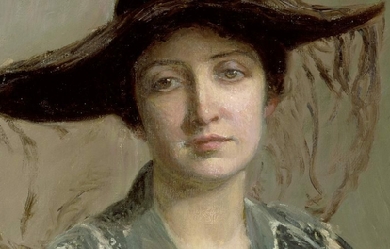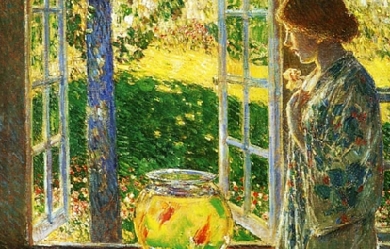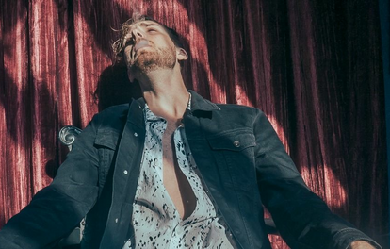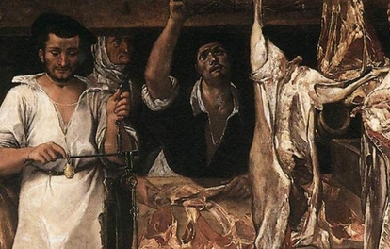All Around the World the Same Song
A few years ago, when I gave a reading at one of a series of conferences an old friend of mine organizes for people from various fields—scientists, inventors, architects, designers, show-biz folk, and even one poet, me—my friend said to the audience, after I was finished, something about how moved he was to think of all the years I’d spent, had to spend, working by myself, all alone and, he implied, lonely. I was startled: I’m quite a gregarious person, and sometimes I do become lonely, but it’s something that never happens to me during the hours I’m at work. When I’m at my desk, my room is filled, overflowing with the presence of a vast number of poets I love, and some others I don’t know at all, whose books or poems have recently arrived but who are there waiting for me to become acquainted with and possibly love, too.
Here are some of the poets that are with me on my desk or the table next to it as I write this: two different translations of Osip Mandelstam’s poems; a book of translations of Giacomo Leopardi; a collection of Thomas Wyatt; another of Gerard Manley Hopkins; an anthology entitled New European Poets, which includes poems from every possible nook and cranny of Europe; a book of essays of Eugenio Montale, as well as his last book of poetry, It Depends, the astonishing singularity of which I only recently came to appreciate; Rainer Maria Rilke’s Duino Elegies; a collection of Blake; Alcools by Guillaume Apollinaire, in French; a book of translations of early Celtic poetry, with those magical strings of modifiers; a translation by Marilyn Hacker of a contemporary French poet, Guy Goffette, whose work I’m not familiar with, but which I plan to read soon; and several anthologies of English and American poetry.
What I find striking about this list is how many different languages, cultures, and moments of history are represented in it. When I first began to write poems at university, we were offered in our courses no poetry whatsoever in languages other than English, except very rarely as exercises in language classes. Still, somehow the first two poets to whom I found myself intimately attached were the French poet Charles Baudelaire and the German, Rainer Maria Rilke. Furthermore, when I was released from university (or perhaps I should say paroled, since I’ve ended back in academe for my livelihood), I found myself during the first years of my apprenticeship, which seems never to have really ended, spending almost all my time with poets from languages and cultures other than English and American. To mention just a few, there were Pablo Neruda; César Vallejo; Federico García Lorca; Miguel Hernández, in Spanish; Baudelaire, again, still, French; and Rilke, German, still as well. Then a little later Arthur Rimbaud, Jean Follain, Francis Ponge; the Polish poets Czesław Miłosz, Tadeusz Rosewicz, and Zbigniew Herbert; Eugenio Montale, Giuseppe Ungaretti, and Pier Paolo Pasolini from Italy; the Alexandrian Greek Constantine P. Cavafy; Tomas Tranströmer, from Sweden; the Russians Anna Akhmatova, Vladimir Mayakovsky, Mandelstam; the classical Chinese, Du Fu and Li Po particularly; as well as the centuries of Japanese haiku masters; even quite a lot of poetry from cultures without a written tradition which were being collected and published or republished around then. And this, as I say, is a very partial accounting.
The question that comes to me now is: why? English certainly has a great poetic tradition, it might actually be the very greatest, so why was I driven so fervently to other languages and cultures? And I should add that I certainly wasn’t alone in this: there was a terrific amount of translating and reading of translations of poetry going on at that time. Many literary journals in the early sixties were crowded with translations from every place in the world, and for a while I think there were as many books of translations being published as poetry in English. Again: why?
I’ve thought sometimes that there were extra-literary reasons for it. Much of this turning outward, this searching for new poetic resources, came during the years of the cold war when America took on, or had imposed on it by circumstances, an imperial sense of itself, an identity of power from which we have suffered and caused much suffering since. There might be something to this, and something also to the fact that there were such profound social changes underway in race and gender relations in America at that time, but I’m not really sure about how much either of these were the reasons for what was happening in poetry. Perhaps because so much of my attention has been devoted to poetry—learning to write it, and learning about it—I’d feel disingenuous if I didn’t limit my reflections to the areas in which I can be less speculative.
It’s one of the miracles of art that no matter how many times we experience a poem, painting, or piece of music, no matter how much time we spend reveling in it, analyzing it, each time we return to it, it feels utterly spontaneous, seeming to be improvised anew as we experience it. Furthermore, if a work even on a tenth reading or viewing or listening, or a hundredth, doesn’t convey that quality of freshness, of renewal, it will seem moribund, perishing before our eyes like a fish on a beach.
The truth is that the creation of art is laborious, or if that’s not quite the word, it certainly is the case that all art is generated out of the necessities of an aesthetic system, its demands and restrictions, as well as its opportunities, its propulsive energy. Such systems are dauntingly intricate, though fortunately many of the variables of an art form will have been absorbed into what might be called the unconscious of the artist before a creative act is undertaken.
Another characteristic of creative systems, what is usually called style, is that they have a terrifically conservative tendency. Styles are always striving to perfect themselves, by which I mean that styles have inherent in them the potential for enactments that no longer depend on anything but the demands of the style itself: neither matter, content, nor, in other words, world. Stylistically, art is always moving from the transparent to the opaque, from trying to make encompassing and as comprehensive as possible its relations with reality, to a state in which its formal dexterity comes to be its most essential requirement. When this happens, usually during the late moments of an artistic era, the execution of style becomes an end in itself, the end in itself: art becomes style displaying itself, preening, showing off.
This is when an artistic style becomes decadent. Decadence in itself isn’t intrinsically bad, it’s unavoidable, and some of the very greatest art is created at the end of the innovation-decadence cycle. What happens then, though, is that some subtle line is crossed, and the gloriously decadent becomes the offensively empty, sterile, and, with no longer any portion of the quest of the artist’s blundering soul a part of it, produces work that is lifeless, stillborn.
This isn’t any great revelation, surely. We all know that when a contemporary painter creates an impressionist painting, no matter how deftly it may be done, no matter how seductive it might appear, it offends, seems at best kitsch, a trivialization, at worst a painful violation, hardly worth being deplored. And when a contemporary poet generates a Keatsian sonnet that isn’t driven by anything in the spiritual cosmos of his or her time, if there is nothing of our difficult contemporary reality infused in the work, and of the poetic history that informs that reality, then experienced readers will find it inert, without essential energy, not worth the effort of bothering with.
Serious artists or writers or composers are acutely aware of all this. At some point in a style’s cycle, and not even necessarily during the decline to decadence, there is the realization that the assumptions that have been informing the style have become rote, and are being executed in accord with formulas that produce nothing but simulacra of the authentic work they once enabled. And, perhaps not surprisingly, this is something that many of the practitioners of an exhausted style experience at almost the same time.
This is what happened to me and to many other poets during the the late fifties and early sixties, when much of the poetry being written in America seemed to have become overly formalized, self-referential, stale, and, if I dare use the word, spiritually lifeless. Artists are always ranging over their own traditions, searching for viable models of inspiration, but I believe that our mostly unconscious realization during those years that we were at a dead end drove many of us to ransack literatures other than our own, no matter how grand our own surely is. We needed—desperately, it felt then—other cultures, other histories, other poetries, in order to discover aesthetics that would disrupt those we’d inherited. We wanted new models that would make unfamiliar demands, and offer new freedom, new inspiration.
In retrospect, needless to say, there were poets who were doing serious, significant work at the time, but each of them seemed to have something about them that for many of us kept them from becoming the inspiration and examples they were later to be. Ginsberg wrote Howl in the fifties, and though it’s now almost universally considered a great poem, when it was published it was received by many poets (including me, I’m sorry to say) as a work that had more to do with the propagation of a world-view rather than being a new kind of poetry. Perhaps because there was so much publicity hysteria around the publication and attempted censorship of the poem, it was difficult to see what its real virtues were. Also during that period William Carlos Williams was still writing, better than he ever had—Pictures from Brueghel, his greatest book, appeared in the early sixties. But for a young poet, Williams seemed to be more of an ancestor: he, along with Robert Frost, who was also still alive though not writing at his best, were poets from the definite past, to be revered, certainly, but whose work didn’t possess that thrust of the unexpected as did poems coming from other languages. Robert Lowell and Richard Wilbur were writing then as well, but until Lowell published Life Studies, they seemed to most of the poets I knew only the very best of the poets working in the conservative conventions of the fifties; admirable, but not the powerful innovative influence Lowell would become with Life Studies and For the Union Dead.
Though my contemporaries and I were certainly aware of the poetry that was being produced in America, we were still most excited by the appearance of another poet from, say, Nigeria, like Wole Soyinka, or Israel, like Yehuda Amichai. This wasn’t the only time in English and American literature when there was this sort of reaching out to other sources. At the turn of the century, when the self-consciously decadent pre-Raphaelite and late Victorian poets were setting the aesthetic standards of their day, the early modernists turned from them, finding in French poetry, poetry from Asia, even early Provençal poetry, new visions and new styles. Similarly, in the early English renaissance, many of the best poets of the time translated Petrarch and other Italian and Latin poets as a way of broadening the scope of what they experienced as a limited range of stylistic possibility. Some of Wyatt’s and Henry Howard’s most famous poems are actually translations, though often our anthologies don’t even remark the fact. And similar things happened in the visual arts: in the late-nineteenth-century, Monet, Van Gogh, and Gauguin, among others, turned to the Japanese print; Manet went to Goya; Picasso and the other cubists to African art.
Today there has been what surely has to be called a globalization of art, and a nearly instantaneous awareness, especially in the market-driven visual arts, of what is happening in other aesthetics. Whether this is all for the good, I’m not certain. While I was reading the anthology of contemporary European poetry I mentioned before, I was struck by how much its poems tended to sound alike: in most cases, I couldn’t really tell what country or language a poetry had come from until I checked. I thought at first that perhaps the almost universal commitment to free verse was the reason for this apparent homogenization, which is a rather distressing thought. It may have been instead because all the translators of the poems in the book were working in American English, and hadn’t sufficiently taken into account the subtleties of the original languages.
Finally, though, however it happens, by whatever complex, forbiddingly imprecise, dauntingly imperfect means, art is created, and beauty manifested. All over the world, if not every day then in every age, beautiful paintings and poems and pieces of music and buildings are generated: one can almost imagine little flaring lights on the surface of the earth, like those seen in photos from space, though they are much more sparse and scattered than the illuminating devices that bespeckle our globe. And then over time these embodiments of the beautiful are harvested, amassed, collected in books, in museums, in concert halls, to be distributed into the lives of individual human beings, to become crucial elements of their existence. Often, our experience of beauty will be the first hint of what each of us at some point will dare call our soul. For don’t those first stirrings of that eternally uncertain, barely grasped notion of something more than mere mind, mere thought, mere emotion, usually first come to us in the line of a poem, a passage of music, of the unreal yet more-than-real image in a painting?
And isn’t it also the case after all that beauty is the one true thing we can count on in a world of insufferable uncertainty, of constant moral conflicts? I’ve wondered sometimes if humans invented gods to have something appropriately sensitive, grand, and wise enough to appreciate these miraculous modes of beauty that are so different in material and quality from anything else in the world. Might gods have first been devised not to assuage our fears and hear our complaints and entreaties, but for there to be identities sufficiently sublime to understand what those first painters and sculptors—and surely, though the words and tunes have been lost, those poets and singers—had wrought?
Perhaps this is why those first great art works were executed deep in caves, so as to be certain the divinities who were their audience wouldn’t be distracted by the wonder of the natural world, and so lose the concentration necessary to glory in, and be glorified by, these singular human creations that equaled and even surpassed what had been given by nature for meditation. And perhaps that’s why poets, who may half-remember such matters, go off into what can look to others like solitary caverns, shadowed with loneliness, but which surely aren’t.





